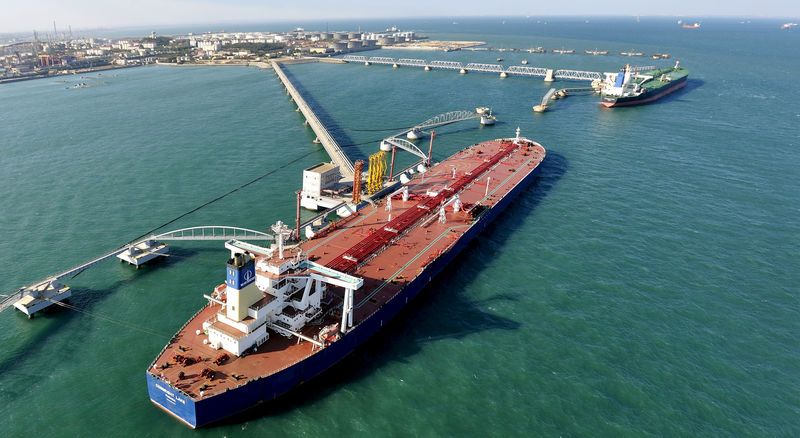By Devika Krishna Kumar, Libby George and Florence Tan
NEW YORK/LONDON/SINGAPORE (Reuters) - Oil futures prices have soared past three-year highs, OPEC's deal has cut millions of barrels of inventory worldwide and investors are betting in record numbers that prices could rocket past $80 and even hit $90 a barrel this year.
But physical markets for oil shipments tell a different story. Spot crude prices are at their steepest discounts to futures prices in years due to weak demand from refiners in China and a backlog of cargoes in Europe. Sellers are struggling to find buyers for West African, Russian and Kazakh cargoes, while pipeline bottlenecks trap supply in west Texas and Canada.
The divergence is notable because traditionally, physical markets are viewed as a better gauge of short-term fundamentals. Crude traders who peddle cargoes to refineries worldwide say speculators are on shaky ground as they drive futures markets above $70 a barrel, their highest levels for three-and-a-half years, on concerns about tighter supply from Venezuela and the potential impact of U.S. sanctions on supply from Iran.
Investors have piled millions of dollars in record wagers in the options market, betting on a further rally on the back of rising geopolitical tensions, particularly in Iran, Saudi Arabia and Venezuela, and the global decline in supply.
"Guys who are trading futures have a view that draws are coming and big draws are coming," a U.S.-based crude trader at a global commodity merchant said, adding that demand could ramp up as global refinery maintenance ends.
"Over the next few weeks, we should start to see markets globally clean up, but if that doesn't happen, I think we could be in trouble."
A RISKY BET?
Brent (LCOc1), the benchmark on which two-thirds of the world's oil is priced, has surpassed $78 a barrel, the highest since November 2014. U.S. crude futures (CLc1) hit a high just short of $72.
Inventories in the developed world are now just 9 million barrels above the five-year average, down from 340 million barrels above the average in January 2017, after supply cuts by the Organization of the Petroleum Exporting Countries and other producers, including Russia.
In the last few weeks, expectations that U.S. President Donald Trump would withdraw from the Iran nuclear agreement added to bullishness. Following Trump's announcement making good on that threat last week, prices surged further. Analysts estimate anywhere from 200,000 to 1 million bpd could be cut from global exports next year.
"Any reduction in Iranian supply will likely exacerbate market deficits, suggesting upward pressure on pricing," wrote Greg Sharenow, PIMCO commodities portfolio manager, which sees oil surpassing $80 in the short term.
In the weeks before Trump's decision, hedge funds and others piled a record number of bets into bullish crude oil options. Traders currently hold a record 21.3 million barrels worth of options that pay off if the December Brent contract hits $90 by late October
These bets are being made due to strong demand, not just fear of political destabilization, said Scott Shelton, energy futures broker with ICAP (LON:NXGN) in Durham, North Carolina.
"The bigger picture of demand keeping up with supply...is much more important," Shelton said.
BIG DISCONNECT
Those on the front lines of the physical market are not convinced. Traders say the surge in U.S. exports to more than 2 million bpd has saturated some markets, leaving benchmark prices ripe for a correction.
"There is a huge disconnect between futures and fundamentals," a trader with a Chinese independent refiner said. "I won't be surprised if prices correct by $20 a barrel."
Increased U.S. competition has dented sales of oil from Nigeria and Azerbaijan, which produce similar quality oil and compete for buyers in Europe and Latin America.
Physical prices have sunk even as benchmarks on which they are based stay buoyant. The strength of Brent crude, now trading at nearly $7 above U.S. futures
Russian Urals hit a seven-year discount against dated Brent
Separately, shipments of West African crude to Asia hit a five-month low in April due to a backlog at Chinese ports.
Clogged pipelines have hit key U.S. oil grades, including in west Texas
Some are confident the world's refineries will gobble up these barrels when they finish seasonal maintenance. About 10 percent of China's refining capacity is expected to be offline through June.
"For the last three, four, five months we've seen high turnarounds globally," a U.S. crude trader said, referencing maintenance works.
"Once you get past that, all of a sudden (you're) looking at 3 million barrels per day of fresh crude consumption."
But whether that is enough to support Brent at $80 and above is yet to be seen.
"I think it's touch and go," he added.
